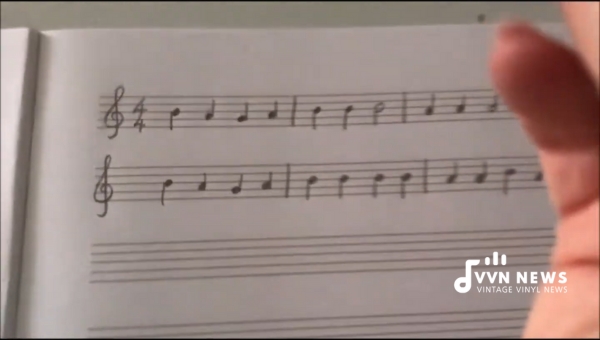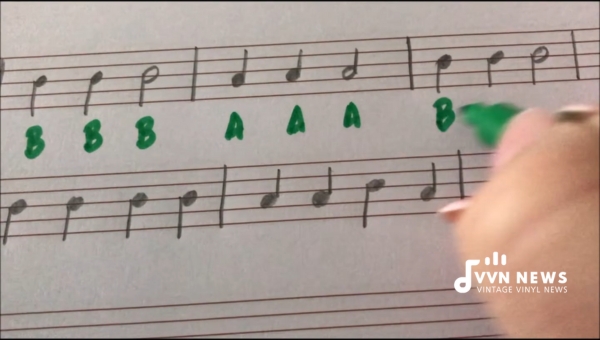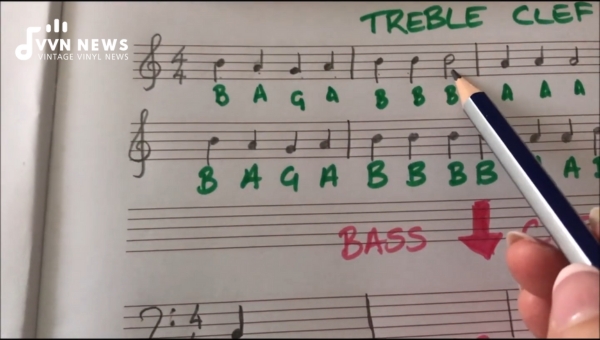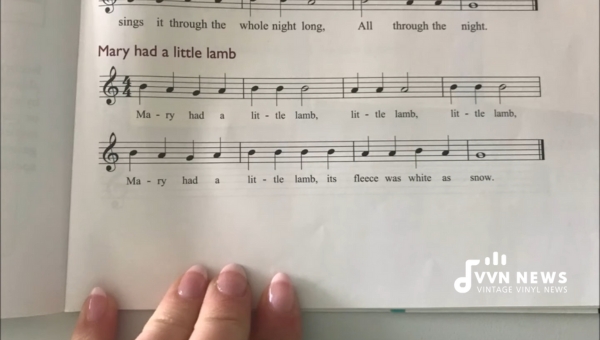Are you a musician who wants to expand your repertoire by learning to play different instruments? Or perhaps you’re a beginner who wants to improve your music sight-reading skills?
In this guide about transpose Bass Clef to Treble Clef, I will provide you with a comprehensive step-by-step guide on how to transpose sheet music from the bass clef to the treble clef.
Transposing music can be a challenging task, but with the right techniques and practice, you can effectively navigate between these two clefs and broaden your musical horizons.
Understanding both the bass clef and treble clef is essential for any musician. The bass clef is typically used for low-pitched instruments like the bass guitar, cello, or trombone. In contrast, the treble clef is commonly written for higher-pitched instruments such as the piano or violin.
Transposing allows musicians to play music written for one instrument on another instrument that uses a different clef.
So, whether you’re a bass guitarist who wants to play a melody on your instrument or a pianist looking to challenge yourself by tackling a piece written originally for double bass – this guide will equip you with the knowledge and skills needed to transpose between these two clefs seamlessly.
What is Transposition in Music?
Transposition refers to the process of changing the pitch of a musical piece. It involves shifting all the notes up or down by a certain interval.
This allows musicians to play music written for one instrument on another instrument that uses a different clef.
Transposition is an essential skill for musicians as it allows them to explore different instruments and expand their repertoire.
It also enables them to adjust the music to suit their vocal range or the range of other instruments they are playing with.
When transposing, it is important to consider both the key signature and the change in the octave between the original and transposed version.
By accurately transposing music, musicians can effectively perform pieces written for different instruments or adapt them to suit their preferences.
Why Transpose Between Bass and Treble Clefs?

Transposing between the bass clef and treble clef opens up a world of possibilities for musicians. Here are some reasons why you might want to transpose between these two clefs:
Expanding your repertoire
Transposition allows you to play music that was originally written for a different instrument.
By transposing from bass clef to treble clef, you can bring melodies typically played by low-pitched instruments, such as the double bass or cello, to higher-pitched instruments like the piano or violin.
Improving sight-reading skills
Learning to transpose from one clef to another enhances your ability to read sheet music and sight-read new pieces effectively.
As you become proficient in transposition, your overall music reading skills will improve, making it easier for you to learn new songs on different instruments.
Adapting music for different instrumental arrangements
If you are playing in a band or ensemble, chances are that each member will have their own preferred instrument and clef.
Being able to transpose the sheet music from bass clef to treble clef (or vice versa) allows everyone in the group to read and play from the same score, regardless of their chosen instrument.
Challenging yourself
Transposing between the bass clef and treble clef can be a great exercise for musicians who want to challenge themselves and expand their musical abilities.
It requires mental agility and an understanding of musical notation.
Transposing between the bass clef and treble clef opens up a world of musical possibilities by allowing you to explore different instruments, improve your sight-reading skills, adapt music for various arrangements, and challenge yourself as a musician.
Also Read: How To Transpose Treble To Bass Clef [Music Guide]
How Do Bass and Treble Clefs Differ?
The bass clef and treble clef are two different notations used in sheet music to represent different ranges of notes.
Each clef is associated with specific instruments or vocal ranges. Here’s a breakdown of how these clefs differ:
Bass Clef (F Clef)
The bass clef, also known as the F clef, is commonly used for low-pitched instruments such as the bass guitar, cello, tuba, and double bass. Its symbol resembles a backward-facing “C” with two dots on it.
Key points about the bass clef:
- It is centered around the F below middle C on the piano.
- The notes on or below middle C (C4) are typically written below the staff lines.
- The lines of the staff in the bass clef represent GBDFA (Good Boys Do Fine Always).
- The spaces between the lines represent ACEG (All Cows Eat Grass).
Treble Clef (G Clef)
The treble clef, also known as the G clef, is predominantly used for higher-pitched instruments like the piano, violin, flute, and guitar. Its symbol resembles a stylized “G” with a dot on its center.
Key points about the treble clef:
- It is centered around the G above middle C on the piano.
- The notes above middle C are usually written above the staff lines.
- The lines of the staff in treble clef correspond to EGBDF (Every Good Boy Deserves Fudge).
- The spaces between the lines represent FACE.
Understanding these differences is crucial when transposing from bass to treble clefs. It involves shifting notes between different octaves and adjusting their positioning within each respective staff.
Being familiar with both notations allows musicians to effectively interpret and play music written for various instruments or vocal ranges, expanding their musical capabilities.
What Steps Are Involved in Transposing?

Transposing music from the bass clef to the treble clef requires a systematic approach. Here are the steps to follow:
- Familiarize Yourself with Both Clefs: Before you begin transposing, make sure you have a solid understanding of both the bass and treble clefs. Study their note ranges, the positioning of notes, and any key signature differences.
- Identify the Key Signature: Look for the key signature in the original bass clef sheet music. This will determine which notes need to be adjusted in your transposition.
- Determine the Interval: Find out how many steps up or down you need to transpose each note to fit within the range of the treble clef. The interval may vary depending on the key signature.
- Transpose Each Note: Start transposing each individual note from bass clef to treble clef. Take into account both the pitch and octave changes based on your determined interval.
- Review for Accuracy: Once you have transposed all the notes, carefully review your work for accuracy. Check that all notes are correctly placed within their new pitch range while maintaining their relative positions.
- Adjust Key Signature and Accidentals: Make any necessary adjustments to match the new key signature of your transposed piece. This may involve adding or removing sharps or flats, as well as adjusting accidentals throughout.
- Double-check for Errors: Take a final look at your transposition to ensure there are no mistakes or inconsistencies between measures or sections of your music.
Remember that transposition can be challenging at first, so it’s essential to practice regularly and listen carefully for any discrepancies in pitch or rhythm.
By following these steps and giving yourself time to familiarize yourself with each clef, you can successfully transpose bass clef music into treble clef notation and vice versa.
With practice, this skill becomes second nature, opening up a wide range of musical possibilities for you as a musician.
Also Read: How To Transpose Music? [Simplifying Key Changes In Songs]
How Can Software Tools Assist in Transposition?
Software tools can be invaluable when it comes to transposing music between the bass clef and treble clef.
They offer a range of features and functionalities that simplify the transposition process and save time for musicians. Here’s how software tools can assist in transposing:
Transposition Functionality
Many music notation software programs, such as Sibelius or Finale, have built-in transposition features. These tools allow musicians to easily transpose sheet music from one clef to another with just a few clicks.
Automated Note Conversion
Software tools can automatically convert the notes from one clef to another while maintaining the correct pitch relationship. This eliminates the need for manual transposition calculations and reduces potential errors.
Key Signature Adjustment
Transposing often involves changing the key signature of a piece. Software tools can automatically adjust the key signature accordingly, ensuring that all notes are correctly interpreted in the transposed version.
Playback Functionality
Software tools often include playback functionality, allowing musicians to hear how the transposed piece sounds before performing it themselves. This is especially beneficial for those who are still developing their sight-reading skills or want to check the accuracy of their transcription.
User-Friendly Interface
Most music notation software programs have intuitive interfaces that make transposing easy even for beginners. They provide clear instructions and options for selecting the desired clefs and intervals, making sure users understand each step of the process.
Instant Transposition
With software tools, transposing sheet music becomes a matter of seconds rather than laborious manual work. Musicians can see the changes in real time as they select different options, allowing them to experiment with multiple possibilities quickly.
Using software tools for transposition simplifies and streamlines the process, freeing up more time for musicians to focus on their performance and musical interpretation.
Common Pitfalls in Transposition of Bass Clef To Treble Clef

Transposing from bass clef to treble clef can be a complex task, especially for beginners. Here are some common pitfalls to look out for:
- Ignoring Key Signatures: One of the most common mistakes in transposition is failing to consider the key signature. Each key has a unique set of sharps or flats, and these must be accounted for when transposing. Make sure to identify the key signature accurately before starting the transposition process.
- Forgetting Octave Changes: When you transpose from bass clef to treble clef, it’s important to take into account the change in octaves between the two clefs. Notes that were played in a lower octave in the bass clef need to be raised by an octave in the treble clef.
- Misinterpreting Note Names: The note names on the lines and spaces of the staff are different between the bass and treble clefs. In the bass clef, notes are typically lower-pitched, while in the treble clef, they are higher-pitched. It’s crucial not to confuse these note names when transposing.
- Failing to Use Accidentals Properly: Accidentals (sharp, flat, or natural symbols) are used to alter the pitch of a note outside of its key signature. In transposition, it’s important to apply accidentals correctly based on both the original key signature and any additional changes required by transposing.
- Not Practicing Enough: Transposition is a skill that requires practice and familiarity with both clefs. Make sure to practice regularly and gradually increase difficulty as you become more comfortable transposing between bass and treble clefs.
- Overlooking Alternative Notation: Some music may use alternative notation or markings specific to certain instruments when written in one clef compared to the other. It’s crucial to be aware of these differences and understand how they affect the transposition process.
Avoiding these common pitfalls will greatly enhance your ability to transpose music effectively from bass clef to treble clef. Take your time, focus on accuracy, and remember that practice makes perfect.
Also Read: How To Transpose Into The Tenor Clef? [Mastering In Notation]
FAQs About Transpose Bass Clef To Treble Clef
Can I transpose any music from the bass clef to the treble clef?
Yes, you can transpose any music from bass clef to treble clef. However, keep in mind that the range of the instruments and their capabilities may differ, so some parts of the music might need adjustments.
How do I determine the interval for transposition?
To determine the interval for transposition, count the number of lines or spaces between the bass and treble clefs. Each line or space represents a specific interval (e.g., a line above or below represents a third).
Do I need to change the key signature when transposing?
Yes, you usually need to change the key signature when transposing. The new key signature should reflect the pitch shift and ensure that all sharps or flats are correctly accounted for in the transposed version.
Are there any common challenges when transposing between bass and treble clefs?
One common challenge is dealing with extreme range differences between instruments. The low notes in bass clef may not be playable on some treble-clef instruments without losing their original sonority.
Can software tools assist in transposing sheet music?
Yes, there are various software tools available that can assist in transposing sheet music. These tools often allow you to input a piece of music and automatically generate a transposed version based on your specifications.
Conclusion
Transposing sheet music from bass clef to treble clef opens up a world of possibilities for musicians.
By understanding the differences between the two clefs and following a systematic approach to transposition, musicians can seamlessly navigate between them.
It is important to pay attention to key signatures and octaves when transposing, and using software tools can greatly assist in this process.
By practicing regularly and honing transposition skills, musicians can confidently play music across different instruments and enhance their overall musical abilities. So go ahead, explore the depths of transposition, and let your musical journey unfold!








